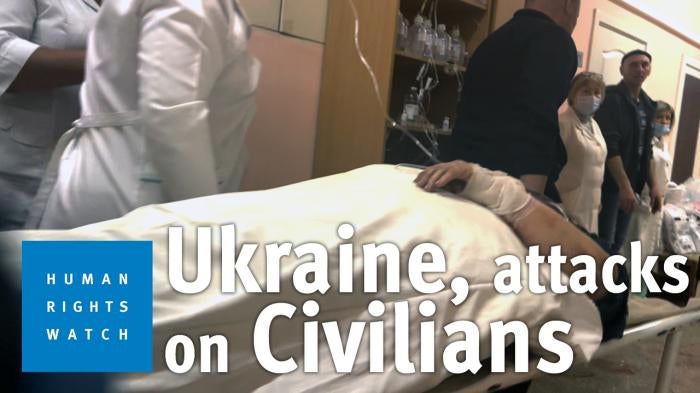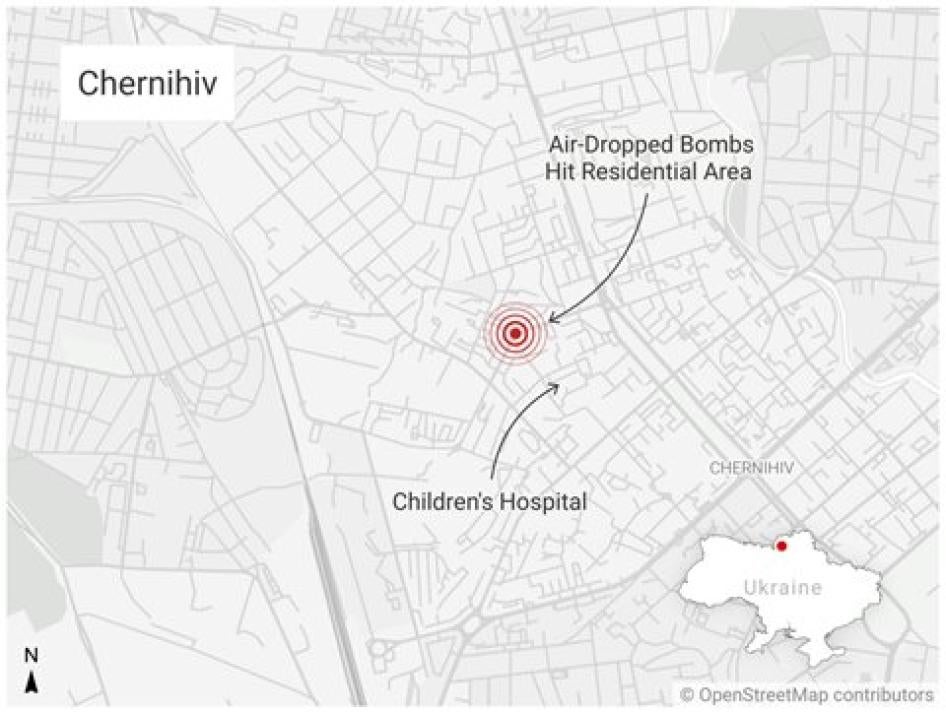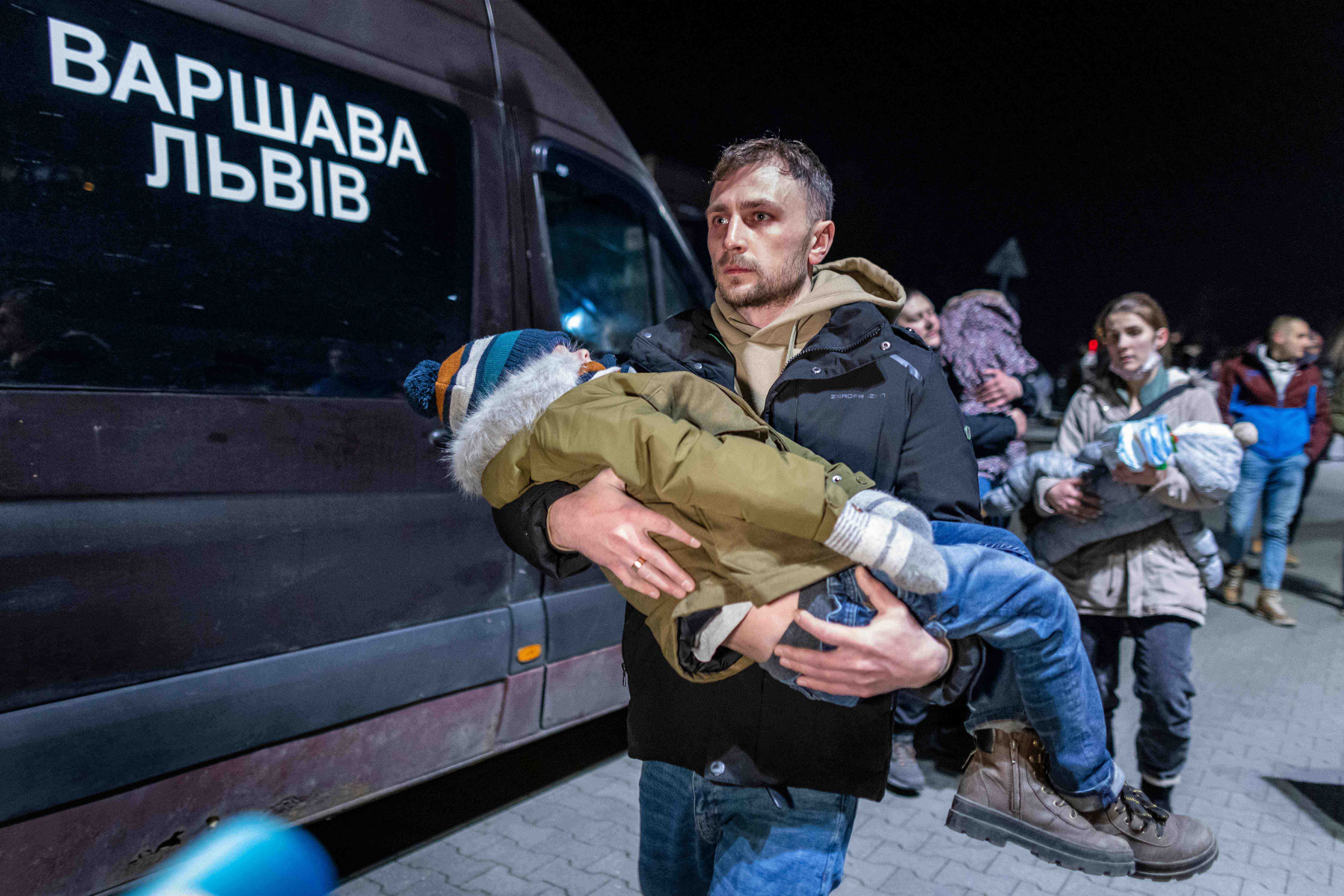Russian aircraft dropped multiple unguided bombs simultaneously on March 3, 2022, that hit an intersection in a residential neighborhood of Chernihiv, a city in northeastern Ukraine, Human Rights Watch said today.
The attack, at about 12:15 p.m. local time, killed at least 47 people, according to local authorities, and wounded many others. It caused significant damage to a high-rise apartment building, a hospital, and several other residential and commercial buildings, one of which contained a pharmacy. Windows have been blown out in most of the buildings surrounding the intersection, and much of the ground is charred and covered with debris.
“Russian forces dropped bombs on a residential neighborhood in the middle of the day, destroying homes, killing and injuring dozens of people, and terrifying residents,” said Ida Sawyer, crisis and conflict director at Human Rights Watch. “The International Criminal Court and other relevant authorities investigating potential crimes in this conflict, should determine if a war crime was committed in Chernihiv and signal clearly that those responsible will be held to account.”
Although Human Rights Watch was unable to conclusively exclude the possibility of a military target in the area at the time, it found no evidence of any such significant target in or near the intersection when it was hit. This suggests that Russian forces violated their obligation under international humanitarian law to take all feasible precautions to avoid or minimize civilian casualties and damage, and points to a potentially deliberate or reckless indiscriminate attack, in so far as it does not appear to have been directed at a specific military target.
Human Rights Watch interviewed by phone three witnesses to the attack, including a doctor and two other Chernihiv residents, as well as two additional Chernihiv residents with knowledge of the attack. Human Rights Watch also verified and analyzed 22 videos and 12 photographs taken during the attack and its aftermath.
A 28-year-old video editor who lives on the 13th floor of the17-story apartment building that was hit, said that he was watching the news with his girlfriend when they heard an air raid siren, the sound of a plane nearby, and then an explosion. They ran into the hallway, closed the apartment door, and hid behind the wall. “Then there was a huge explosion,” he said. “Everything was covered in dust. We were worried about a fire, so we started going downstairs. We saw doors were blown out in all the apartments, and the apartments were completely destroyed; we could see the sky through them.” They eventually made it to the building’s basement.
From the high vantage point of his window on the 13th floor, he said he had not seen any military vehicles or soldiers in the area before the attack or even in the previous days. He said that to the best of his knowledge, “there are no military objects in our neighborhood, and no strategic objects.” In his view the bombing was “to break our will.” Other witnesses also consistently said that they were not aware of any military operations or military targets in the area. No one reported hearing any warnings in advance of the attack.
He said that his building is the tallest in the neighborhood, with shops on the ground floor, including a popular meat market and a place that sells clean water. It’s a residential neighborhood, with several hospital buildings nearby as well as grocery stores and pharmacies.
Another witness said he was buying groceries and as he left the store, he heard a “big boom.” Then “smoke just came all around us,” he said.
A doctor at a nearby children’s hospital said he was in the basement when suddenly he saw people running down from the ground floor. “It was like a windstorm as the whole basement filled up with dust,” he said. “Then there was an explosion. Several windows were blown out [in a nearby building], and there was a lot of vibration. We have explosions every day, but this one was very powerful.”
The doctor said that he and his colleagues were still able to treat 35 injured people who arrived within an hour after the attack. The injured included men, women, and children ranging in age from 7 to 55. The doctor said he saw injuries consistent with primary, secondary, and tertiary fragmentation wounds. A 9-year-old boy’s ankle was cut open, and an 8-year-old girl was hit in her face with a fragment. Both were transferred to the trauma unit. An 11- or 12-year-old boy was transferred to the intensive care unit because of metal shards in his brain and damage to his skull. A man who was dead on arrival at the hospital had serious skull damage.
The doctor said that the hospital was short on basic medical supplies to treat the wounded and lacked sufficient materials to stem bleeding and other first aid treatment, antibiotics, devices for fixing bones after fractures, and infusion equipment.
The doctor also said the hospital was struggling to continue providing care for the patients who had been receiving treatment before the attack. A volunteer coordinating humanitarian aid at the hospital recorded the aftermath and later shared the footage with Human Rights Watch, which Human Rights Watch independently verified. The 11 videos recorded on March 3 included 1 recorded outside the hospital 2 minutes after the attack began.
Another video, recorded on the morning of March 4, included an interview with a woman holding her 2-year-old son who had been undergoing treatment for leukemia. “We’re in the final steps of treatment [chemotherapy], and we really need to finish the process so we can avoid the horrible idea of relapse,” she told him. But because of the repeated Russian attacks on Chernihiv, she said, it has been impossible to continue the treatment. “Above all else, I want to be somewhere safe and continue treatment. To leave a city which is being occupied, more and more every day, every hour.”
Footage from the hospital in the aftermath of the attack shows two men wearing Ukrainian military uniforms – one seriously wounded, lying on a gurney – and another six people with yellow armbands who appear to be members of the citizen volunteer Territorial Defense Forces. It is unclear whether they were in the area at the time of the attack. However, even if some members of these forces were in the general vicinity of the attack, it is unlikely that it would justify the attack militarily as proportionate, given the extent of civilian loss of life and injury as well as the damage to civilian objects, Human Rights Watch said.
Intentional or reckless disproportionate attacks are war crimes and each party to the conflict must do everything feasible to assess whether an attack may be expected to cause, individually or combined, this kind of incidental civilian loss, which would be excessive in relation to the concrete and direct military advantage anticipated.
International humanitarian law, or the laws of war, prohibit attacks or the threat of attacks whose primary purpose is to spread terror among the civilian population. Attacks against civilian objects that have no evident military purpose could violate this prohibition.
Ukrainian forces also have an obligation to take all feasible precautions to protect the civilian population and civilian objects under their control against the effects of attacks. Such precautions include avoiding operating from an area where civilians and civilian objects are located and preventing civilians from entering areas of active hostilities.
The use of explosive weapons with wide-area effects in populated areas heightens concerns of unlawful, indiscriminate, and disproportionate attacks. These weapons have a large destructive radius, are inherently inaccurate, or deliver multiple munitions at the same time. This includes the use of unguided and unobserved large-caliber projectiles and aviation bombs, such as those that were used during the March 3 attack in Chernihiv. The use of these weapons should be avoided in populated areas.
The new International Criminal Court investigation of the events in Ukraine and the United Nations Commission of Inquiry should investigate the March 3 attack in Chernihiv, Human Rights Watch said.
“The consequences of the attack that rocked Chernihiv on March 3 will be felt for some time to come, while residents are also living under the constant threat of new attacks,” Sawyer said. “Parties to the conflict should ensure that all Chernihiv residents have access to the medical care that they need, and that civilians are able to leave the city safely.”










